A classic Japanese autumn soup, Matsutake Suimono (Clear Soup) is cooked with seasonal matsutake mushrooms, tofu and mitsuba herb in a clear dashi broth. It’s absolutely nourishing and packed with health benefits.
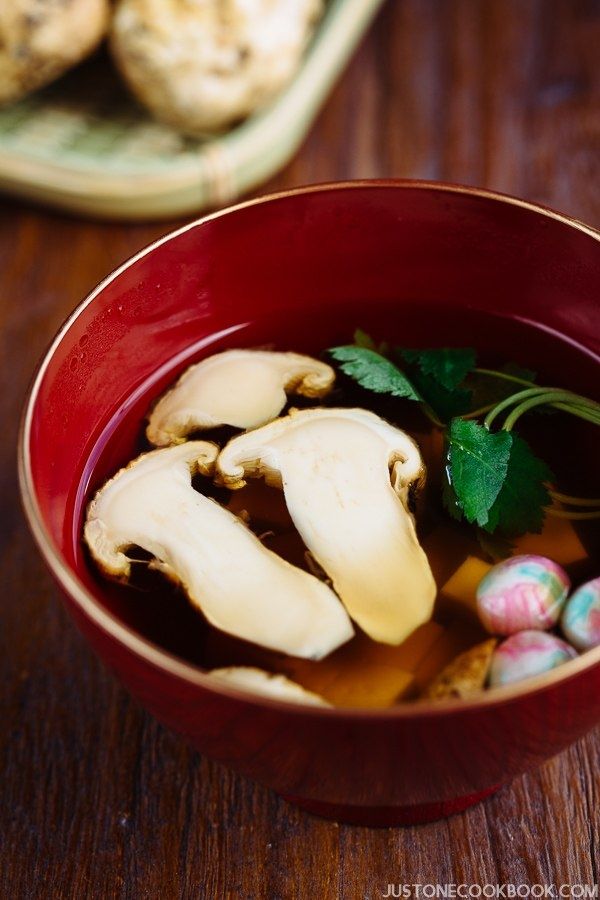
Matsutake Soup (松茸お吸い物) is a classic Japanese autumn soup with highly-prized fragrant matsutake mushrooms in clear dashi broth. This type of soup does not have miso paste, and is called Suimono or Osuimono which means “food you can sip”.
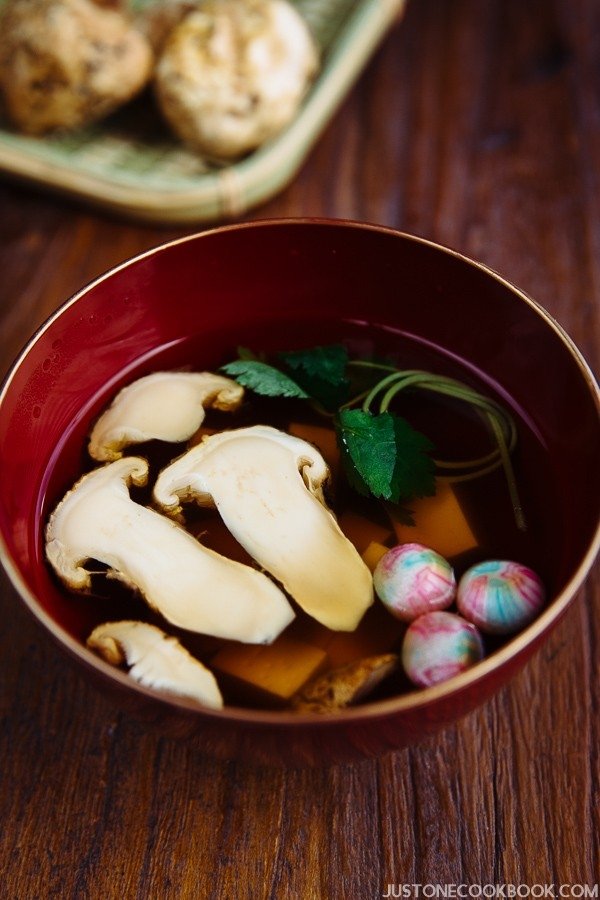
What is Matsutake Mushroom?
If you are a seasoned mushroom forager or mushroom connoisseur, you’ve probably heard of matsutake mushrooms.
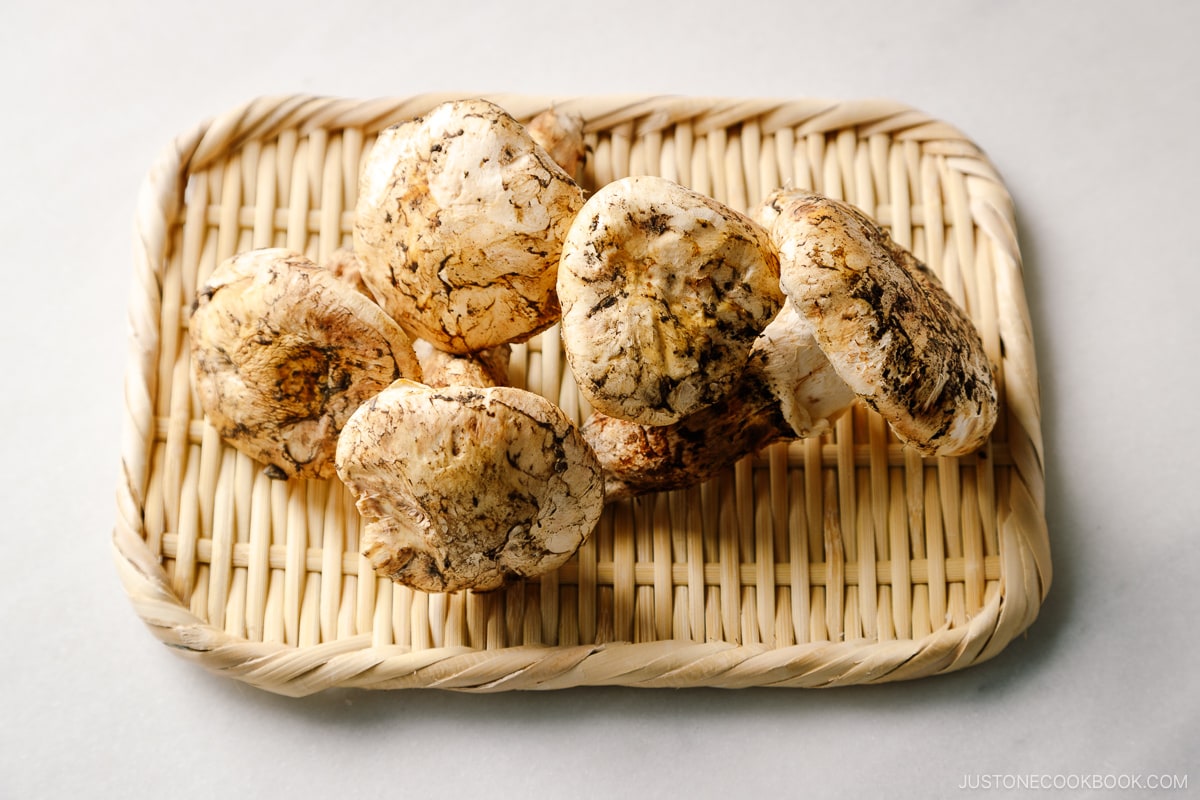
An aromatic mushroom found near specific species of pine tree, matsutake are large firm mushrooms that are ivory in color. In Japanese, matsu (松) means pine and take (茸) means mushroom. It has a very distinct taste and smell like no other food. Imagine a mushroom with extremely concentrated smell of pine wood. Matsutake holds a special place in the culinary world in Japan just like truffles are to French people. We also strongly believe that eating matsutake have many health benefits and one of it includes reducing the free radicals that lead to cancer.
The Japanese has many different preparations for this savory mushroom. One of the simplest ways to enjoy this prized mushroom is by simply grilling it and seasoned with only soy sauce and mirin. We also use it to infuse other dishes like rice or chawanmushi.
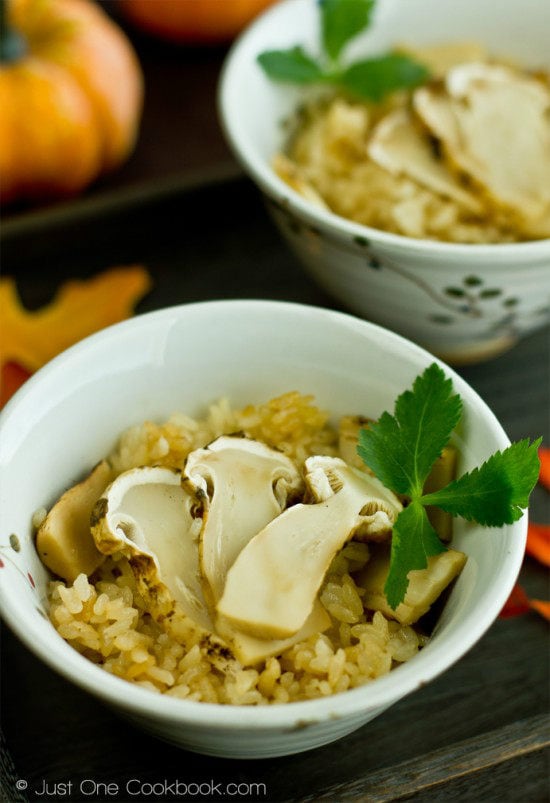
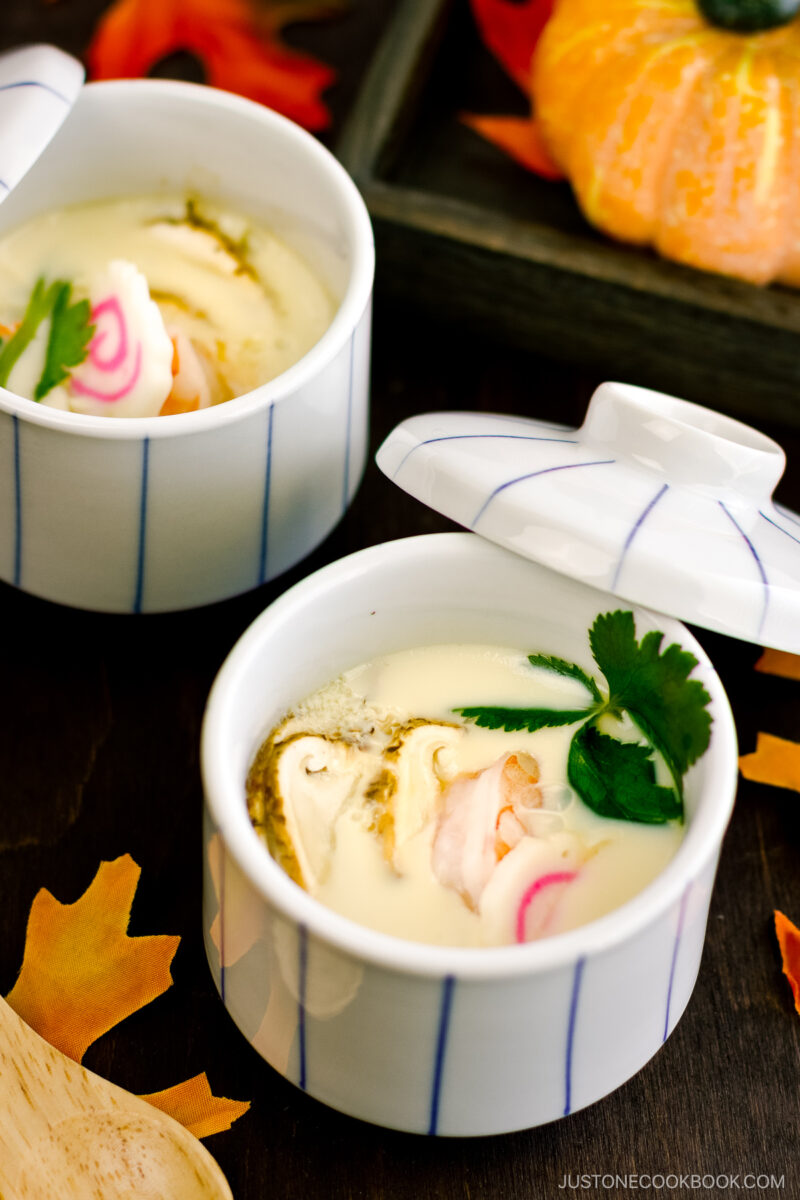
In Japan, due to an issue with pine roundworm, the production has decreased over the past few decades. However, the mushroom is also grown in other parts of the world. The ones I buy from the local market are from the US (Oregon/Washington areas).
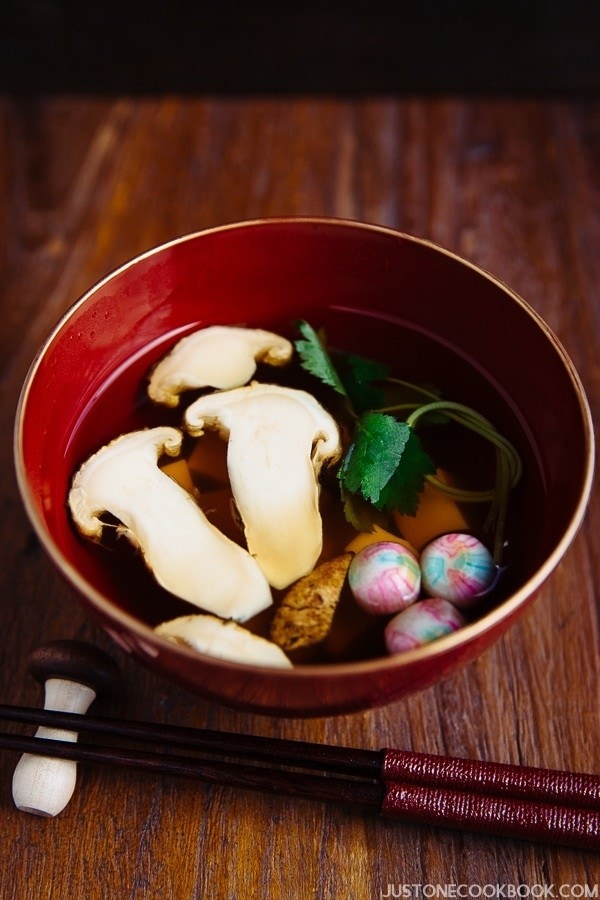
Alternatives to Matsutake Mushroom
For this clear soup recipe, if you cannot find matsutake locally, you can substitute with other kind of mushrooms. You can also experiment with other ingredients you think that will work for a clear delicate soup. My recommendation is to choose ingredients with simple flavor as they can’t overpower the subtle yet rich flavor of dashi broth. Try to combine a nice selection of colors and shapes.
As for dashi, you can use convenient dashi powder instead of making the dashi soup base from scratch to save time. But for a simple dish like this where seasonings are minimal, good broth made from scratch will make a huge difference for the resulting flavor. For this simple homemade dashi recipe, I cut down some extra steps from my original dashi recipe. All you need is kombu and katsuobushi, and they are available at most Asian supermarkets and not necessarily just in Japanese supermarkets.
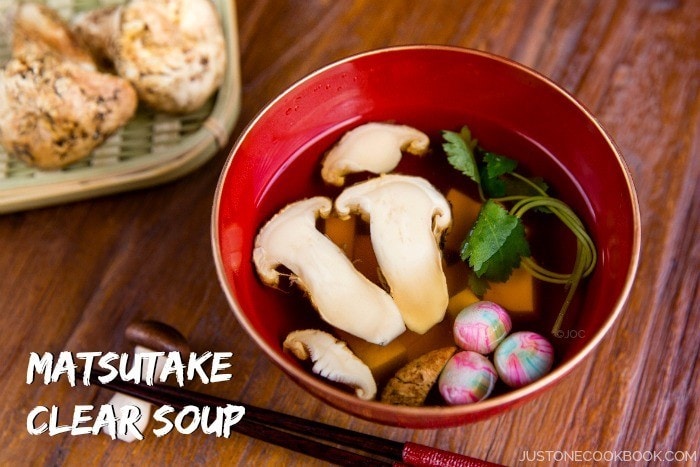
Looking at the image above, you might wonder about those cute little pink balls in the soup. They are called Temari Fu (手まり麩). Fu (麩) or Ofu (お麩) is wheat gluten that is often used as meat substitutes (read more details here). Temari is a traditional Japanese ball made by kimono scraps (see the photo below). I included these balls to add nice accent to the color of the soup. I brought these back from my Japan trip, and unfortunately this type of fu is hard to find outside of Japan.
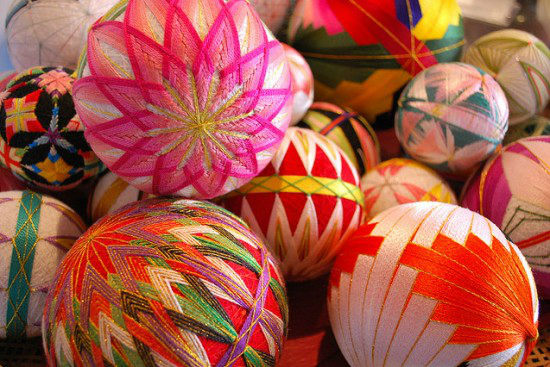
Aren’t they beautiful? You can try making these gorgeous Temari Sushi!
Aromatic, healing, and cleansing, Matsutake Soup can literally warm you from head to heart when the weather is starting to cool down. I hope you enjoy the recipe as much as I do.
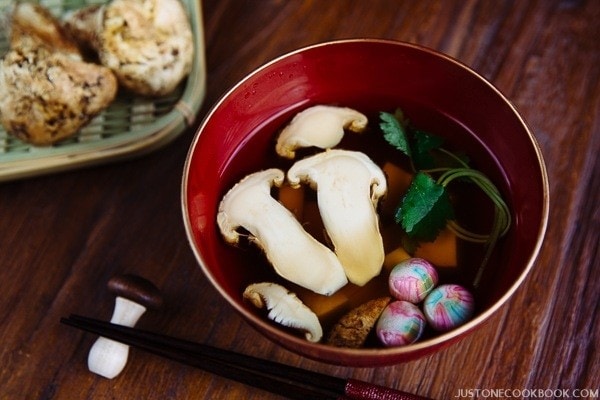
Wish to learn more about Japanese cooking? Sign up for our free newsletter to receive cooking tips & recipe updates! And stay in touch with me on Facebook, Pinterest, YouTube, and Instagram.
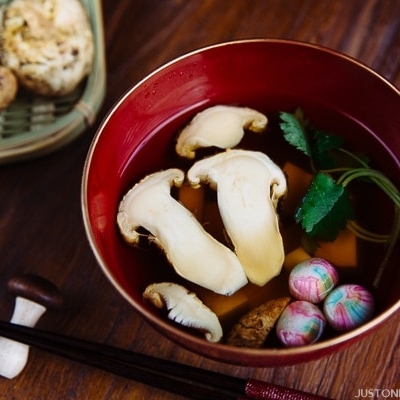
Matsutake Clear Soup (Suimono)
Video
Ingredients
- 1 matsutake mushroom (1.1 oz, 31 g; use other kinds of mushrooms if matsutake is not available)
- 5 oz soft/silken tofu (kinugoshi dofu) (3 x 1.5 inches, 7.6 x 3.8 cm)
- 4 Temari Fu (wheat gluten) (optional; I bought it in Japan)
- 4 sprigs mitsuba (Japanese parsley) (substitute it with a green onion/scallion)
- yuzu zest (or lemon peel)
For the Dashi
- 2 cups water
- 1 piece kombu (dried kelp) (0.2 oz, 5 g; 3 x 3 inches, 7.6 x 7.6 cm per piece)
- 1 cup katsuobushi (dried bonito flakes) (0.4 oz; 1 handful)
For the Seasonings
- 1 Tbsp sake
- 2 tsp mirin
- 2 tsp soy sauce
- ½ tsp Diamond Crystal kosher salt
Instructions
- Gather all the ingredients.

To Prepare the Ingredients
- Clean 1 matsutake mushroom with a damp paper towel. Because mushrooms absorb moisture like a sponge, we try not to wash the mushroom. Shave off a thin sliver of the mushroom stem as if you are sharping a pencil with a knife. Cut into thin slices.

- Tie a knot in each stem of 4 sprigs mitsuba (Japanese parsley). If you use scallion, finely slice it.

To Make the Dashi
- Gently clean 1 piece kombu (dried kelp) with a damp cloth but leave the white powdery substance which contributes to the umami flavor in the dashi. Do not wash the kombu.

- In a medium pot, put the kombu in 2 cups water. Heat up slowly on medium-low heat. If you have time, soak for 3 hours ahead of time or preferably overnight. The kombu’s flavor comes out naturally from soaking in water.

- When boiling, add 1 cup katsuobushi (dried bonito flakes). Simmer for just 30 seconds and turn off the heat.

- Strain the dashi through a fine-mesh sieve set over a bowl. Gently squeeze to release the extra dashi into the bowl.

To Make the Soup
- Transfer the dashi back to the saucepan and bring to a boil. Add the seasonings: 1 Tbsp sake, 2 tsp mirin, 2 tsp soy sauce, and ½ tsp Diamond Crystal kosher salt.

- Cut 5 oz soft/silken tofu (kinugoshi dofu) into small cubes and add to the soup. Then, add sliced matsutake mushrooms and cook until ingredients are heated through, about 2–3 minutes.

- Soak 4 Temari Fu (wheat gluten) in water to hydrate. When the temari fu is soft, squeeze the water out and place it in a serving bowl.

- Add the mitsuba to the soup right before serving.

To Serve
- Serve the soup into bowls and garnish with yuzu zest on top.
Nutrition
Editor’s Note: The post was originally published on October 12, 2014. The content has been updated in October 2017.
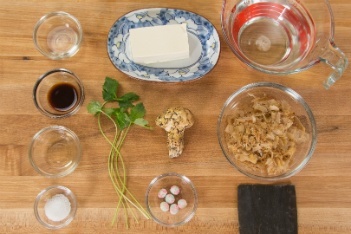

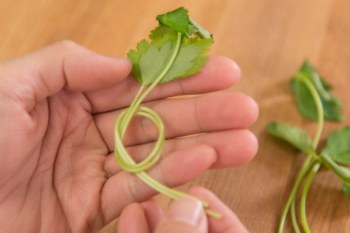
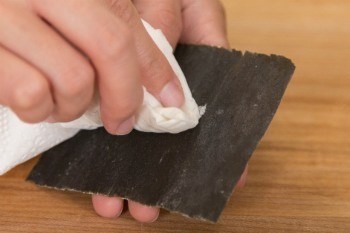
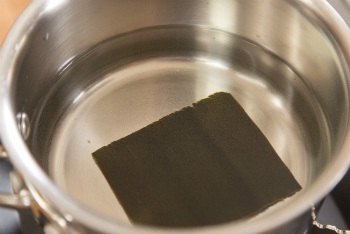

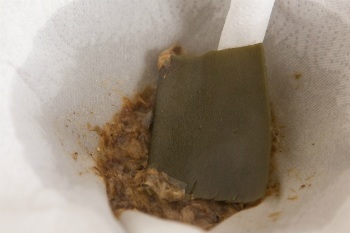
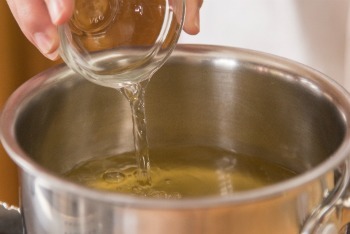


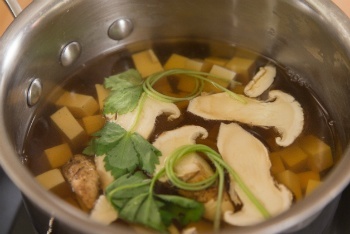










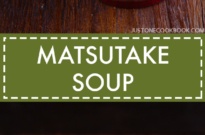
Hello! Looks great can’t wait to try – mah I know instead of making the dashi from scratch can I simply use boil a dashi packet ? Thanks!
Hi Claire! Thank you for trying Nami’s recipe!
Yes, you can use the Dashi packet. But make sure to use the Katsuo dashi packet and Kombu for a better result. Iriko dashi would be a bit too strong for this Matsutake.
We hope this helps!
Thank you very much for so generously providing this beautiful recipe, Namiko! Should the yuzu zest be added as a final touch upon serving?
Hi Taylor! Thank you for checking with us!
Yes, would you please add Yuzu zest as a final touch upon serving?
Thank you very much for trying Nami’s recipe!
Can you recommend a substitute for mitsuba? It is not always available at my Japanese grocer. Thank you!
Hi Cathy,
You may use Mizuna (Potherb mustard), Cilantro (Pakuchi or Coriander), or Celery as a substitute.
We hope this helps!
[…] Japanese restaurants make a huge batch of dashi daily. They use Ichiban Dashi for dishes like Clear Soups (Osumashi おすまし) and Chawanmushi, which require the pure and maximum amount of umami from […]
[…] Clear Soup […]
I had this soup whilst staying in a temple on Koya-san and I’m so excited to make it at home. Your website is so fantastic, thanks so much for your hard work!
Hi Ben! Ohhh you went to Koya-san! I hope you had a great experience. I also have Kenchinjiru recipe which is a vegan recipe too.
https://www.justonecookbook.com/kenchinjiru/
Thank you for the recipe!! I like to go to some of the Japanese restaurants and get hibachi. They usually serve clear soup and salad with it and I always get 2 soups and no salad.
Hi Cam! Sounds like you really enjoy the soup! I hope you like this recipe. 🙂
Man, I was dying for soup tonight and I couldn’t think of what I wanted to do… I wanted something simple and fast, so I had hyper-quick ramen… It was still good, but wasn’t quite what I wanted. This totally looks like it would’ve hit the spot just right. I don’t have matsutake, but I like keeping shitake on hand.
I wonder if matsutake is available in my area…probably not, but it’s worth a look. 😀
Hi Kai! This soup is very nice with aroma from ingredients you use (as the broth is very simple). 🙂 Shiitake is excellent choice, too! Hope you can find matsutake mushrooms somewhere in your area (usually mushroom specialized store, Japanese markets…). 🙂
Lovely!!!
Thank you Lyn!